Ziru Liu
LLM-Powered User Simulator for Recommender System
Dec 22, 2024



Abstract:User simulators can rapidly generate a large volume of timely user behavior data, providing a testing platform for reinforcement learning-based recommender systems, thus accelerating their iteration and optimization. However, prevalent user simulators generally suffer from significant limitations, including the opacity of user preference modeling and the incapability of evaluating simulation accuracy. In this paper, we introduce an LLM-powered user simulator to simulate user engagement with items in an explicit manner, thereby enhancing the efficiency and effectiveness of reinforcement learning-based recommender systems training. Specifically, we identify the explicit logic of user preferences, leverage LLMs to analyze item characteristics and distill user sentiments, and design a logical model to imitate real human engagement. By integrating a statistical model, we further enhance the reliability of the simulation, proposing an ensemble model that synergizes logical and statistical insights for user interaction simulations. Capitalizing on the extensive knowledge and semantic generation capabilities of LLMs, our user simulator faithfully emulates user behaviors and preferences, yielding high-fidelity training data that enrich the training of recommendation algorithms. We establish quantifying and qualifying experiments on five datasets to validate the simulator's effectiveness and stability across various recommendation scenarios.
Modeling User Retention through Generative Flow Networks
Jun 10, 2024



Abstract:Recommender systems aim to fulfill the user's daily demands. While most existing research focuses on maximizing the user's engagement with the system, it has recently been pointed out that how frequently the users come back for the service also reflects the quality and stability of recommendations. However, optimizing this user retention behavior is non-trivial and poses several challenges including the intractable leave-and-return user activities, the sparse and delayed signal, and the uncertain relations between users' retention and their immediate feedback towards each item in the recommendation list. In this work, we regard the retention signal as an overall estimation of the user's end-of-session satisfaction and propose to estimate this signal through a probabilistic flow. This flow-based modeling technique can back-propagate the retention reward towards each recommended item in the user session, and we show that the flow combined with traditional learning-to-rank objectives eventually optimizes a non-discounted cumulative reward for both immediate user feedback and user retention. We verify the effectiveness of our method through both offline empirical studies on two public datasets and online A/B tests in an industrial platform.
M3oE: Multi-Domain Multi-Task Mixture-of Experts Recommendation Framework
Apr 29, 2024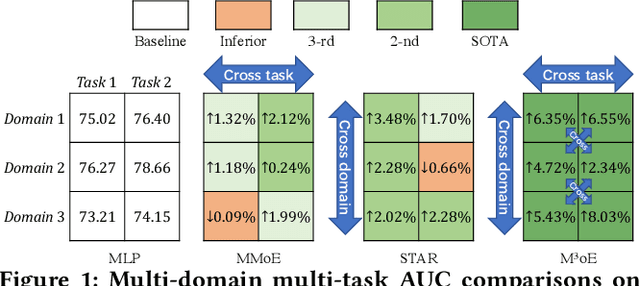

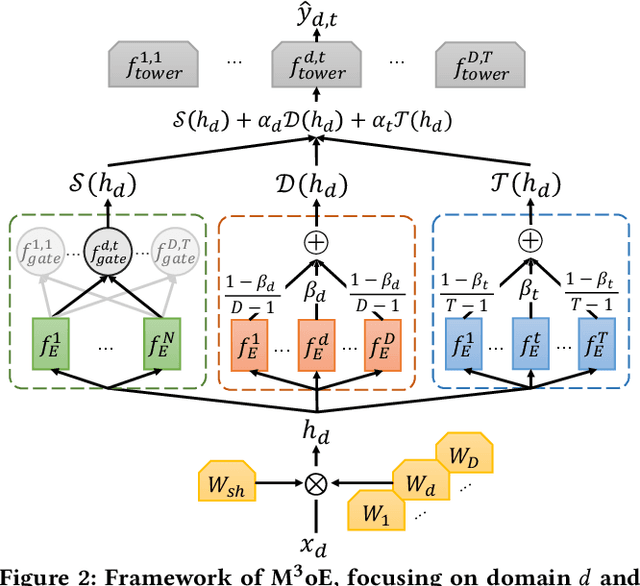
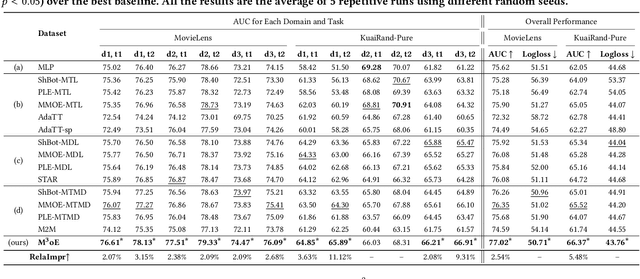
Abstract:Multi-domain recommendation and multi-task recommendation have demonstrated their effectiveness in leveraging common information from different domains and objectives for comprehensive user modeling. Nonetheless, the practical recommendation usually faces multiple domains and tasks simultaneously, which cannot be well-addressed by current methods. To this end, we introduce M3oE, an adaptive multi-domain multi-task mixture-of-experts recommendation framework. M3oE integrates multi-domain information, maps knowledge across domains and tasks, and optimizes multiple objectives. We leverage three mixture-of-experts modules to learn common, domain-aspect, and task-aspect user preferences respectively to address the complex dependencies among multiple domains and tasks in a disentangled manner. Additionally, we design a two-level fusion mechanism for precise control over feature extraction and fusion across diverse domains and tasks. The framework's adaptability is further enhanced by applying AutoML technique, which allows dynamic structure optimization. To the best of the authors' knowledge, our M3oE is the first effort to solve multi-domain multi-task recommendation self-adaptively. Extensive experiments on two benchmark datasets against diverse baselines demonstrate M3oE's superior performance. The implementation code is available to ensure reproducibility.
Sequential Recommendation for Optimizing Both Immediate Feedback and Long-term Retention
Apr 04, 2024
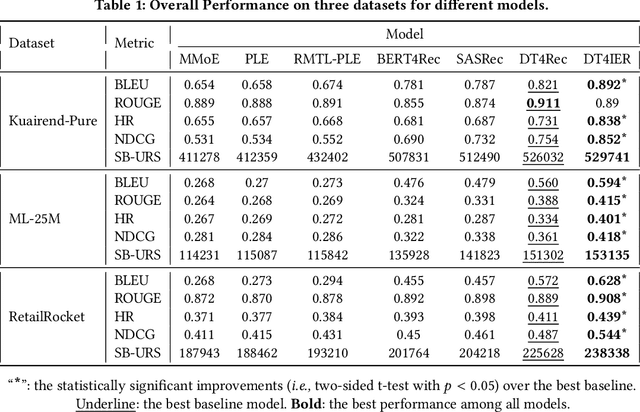
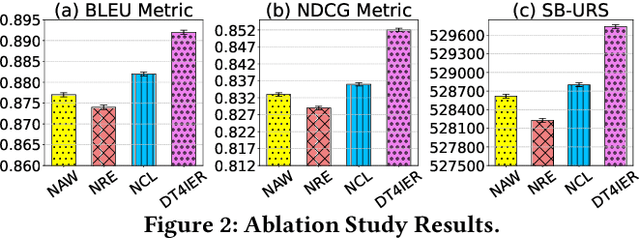
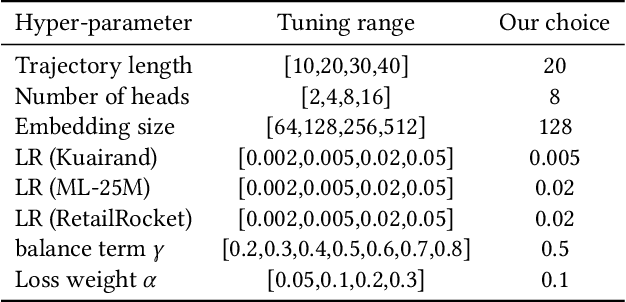
Abstract:In the landscape of Recommender System (RS) applications, reinforcement learning (RL) has recently emerged as a powerful tool, primarily due to its proficiency in optimizing long-term rewards. Nevertheless, it suffers from instability in the learning process, stemming from the intricate interactions among bootstrapping, off-policy training, and function approximation. Moreover, in multi-reward recommendation scenarios, designing a proper reward setting that reconciles the inner dynamics of various tasks is quite intricate. In response to these challenges, we introduce DT4IER, an advanced decision transformer-based recommendation model that is engineered to not only elevate the effectiveness of recommendations but also to achieve a harmonious balance between immediate user engagement and long-term retention. The DT4IER applies an innovative multi-reward design that adeptly balances short and long-term rewards with user-specific attributes, which serve to enhance the contextual richness of the reward sequence ensuring a more informed and personalized recommendation process. To enhance its predictive capabilities, DT4IER incorporates a high-dimensional encoder, skillfully designed to identify and leverage the intricate interrelations across diverse tasks. Furthermore, we integrate a contrastive learning approach within the action embedding predictions, a strategy that significantly boosts the model's overall performance. Experiments on three real-world datasets demonstrate the effectiveness of DT4IER against state-of-the-art Sequential Recommender Systems (SRSs) and Multi-Task Learning (MTL) models in terms of both prediction accuracy and effectiveness in specific tasks. The source code is accessible online to facilitate replication
KuaiSim: A Comprehensive Simulator for Recommender Systems
Sep 22, 2023



Abstract:Reinforcement Learning (RL)-based recommender systems (RSs) have garnered considerable attention due to their ability to learn optimal recommendation policies and maximize long-term user rewards. However, deploying RL models directly in online environments and generating authentic data through A/B tests can pose challenges and require substantial resources. Simulators offer an alternative approach by providing training and evaluation environments for RS models, reducing reliance on real-world data. Existing simulators have shown promising results but also have limitations such as simplified user feedback, lacking consistency with real-world data, the challenge of simulator evaluation, and difficulties in migration and expansion across RSs. To address these challenges, we propose KuaiSim, a comprehensive user environment that provides user feedback with multi-behavior and cross-session responses. The resulting simulator can support three levels of recommendation problems: the request level list-wise recommendation task, the whole-session level sequential recommendation task, and the cross-session level retention optimization task. For each task, KuaiSim also provides evaluation protocols and baseline recommendation algorithms that further serve as benchmarks for future research. We also restructure existing competitive simulators on the KuaiRand Dataset and compare them against KuaiSim to future assess their performance and behavioral differences. Furthermore, to showcase KuaiSim's flexibility in accommodating different datasets, we demonstrate its versatility and robustness when deploying it on the ML-1m dataset.
AutoAssign+: Automatic Shared Embedding Assignment in Streaming Recommendation
Aug 14, 2023Abstract:In the domain of streaming recommender systems, conventional methods for addressing new user IDs or item IDs typically involve assigning initial ID embeddings randomly. However, this practice results in two practical challenges: (i) Items or users with limited interactive data may yield suboptimal prediction performance. (ii) Embedding new IDs or low-frequency IDs necessitates consistently expanding the embedding table, leading to unnecessary memory consumption. In light of these concerns, we introduce a reinforcement learning-driven framework, namely AutoAssign+, that facilitates Automatic Shared Embedding Assignment Plus. To be specific, AutoAssign+ utilizes an Identity Agent as an actor network, which plays a dual role: (i) Representing low-frequency IDs field-wise with a small set of shared embeddings to enhance the embedding initialization, and (ii) Dynamically determining which ID features should be retained or eliminated in the embedding table. The policy of the agent is optimized with the guidance of a critic network. To evaluate the effectiveness of our approach, we perform extensive experiments on three commonly used benchmark datasets. Our experiment results demonstrate that AutoAssign+ is capable of significantly enhancing recommendation performance by mitigating the cold-start problem. Furthermore, our framework yields a reduction in memory usage of approximately 20-30%, verifying its practical effectiveness and efficiency for streaming recommender systems.
Learning Empirical Bregman Divergence for Uncertain Distance Representation
Apr 18, 2023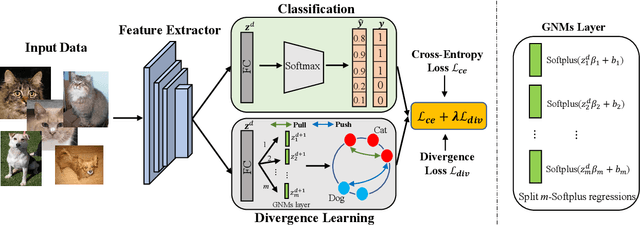
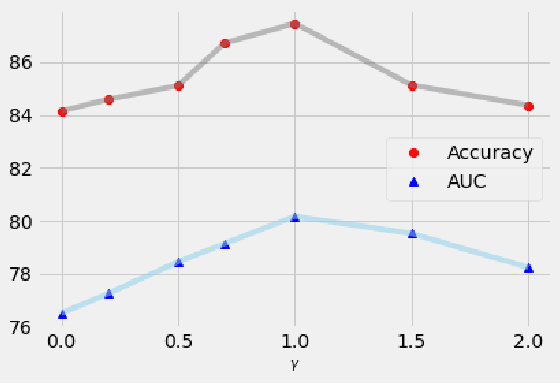
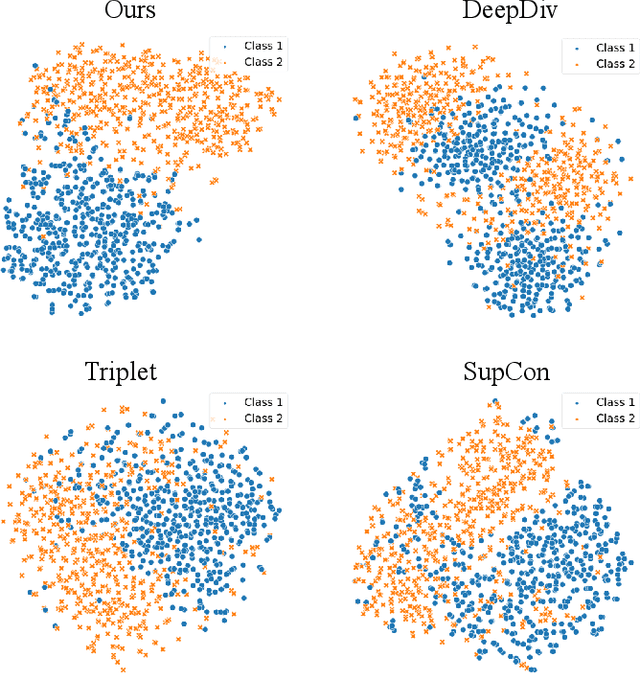
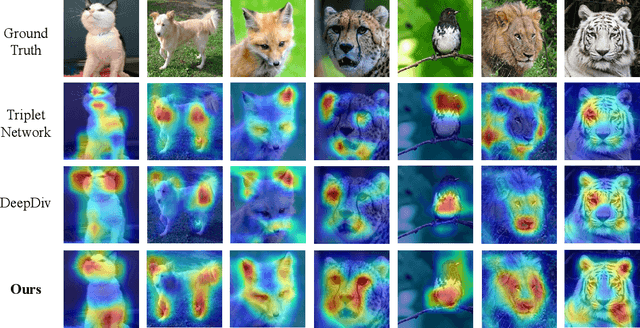
Abstract:Deep metric learning techniques have been used for visual representation in various supervised and unsupervised learning tasks through learning embeddings of samples with deep networks. However, classic approaches, which employ a fixed distance metric as a similarity function between two embeddings, may lead to suboptimal performance for capturing the complex data distribution. The Bregman divergence generalizes measures of various distance metrics and arises throughout many fields of deep metric learning. In this paper, we first show how deep metric learning loss can arise from the Bregman divergence. We then introduce a novel method for learning empirical Bregman divergence directly from data based on parameterizing the convex function underlying the Bregman divergence with a deep learning setting. We further experimentally show that our approach performs effectively on five popular public datasets compared to other SOTA deep metric learning methods, particularly for pattern recognition problems.
Multi-Task Deep Recommender Systems: A Survey
Feb 09, 2023Abstract:Multi-task learning (MTL) aims at learning related tasks in a unified model to achieve mutual improvement among tasks considering their shared knowledge. It is an important topic in recommendation due to the demand for multi-task prediction considering performance and efficiency. Although MTL has been well studied and developed, there is still a lack of systematic review in the recommendation community. To fill the gap, we provide a comprehensive review of existing multi-task deep recommender systems (MTDRS) in this survey. To be specific, the problem definition of MTDRS is first given, and it is compared with other related areas. Next, the development of MTDRS is depicted and the taxonomy is introduced from the task relation and methodology aspects. Specifically, the task relation is categorized into parallel, cascaded, and auxiliary with main, while the methodology is grouped into parameter sharing, optimization, and training mechanism. The survey concludes by summarizing the application and public datasets of MTDRS and highlighting the challenges and future directions of the field.
Multi-Task Recommendations with Reinforcement Learning
Feb 07, 2023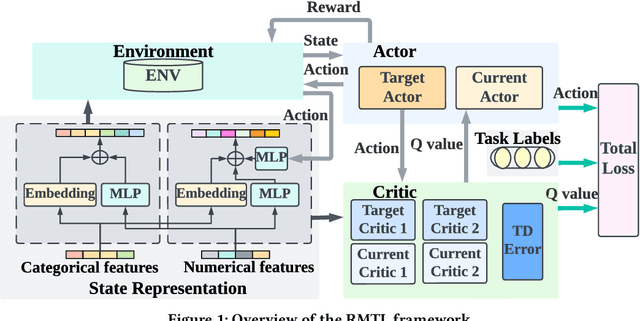
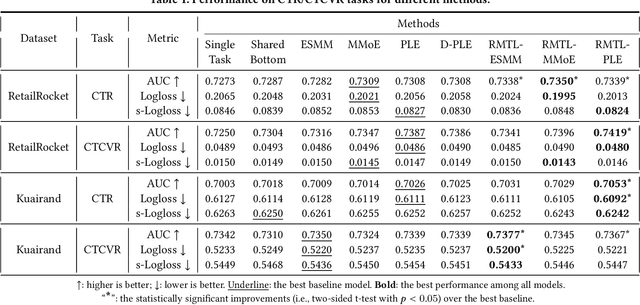
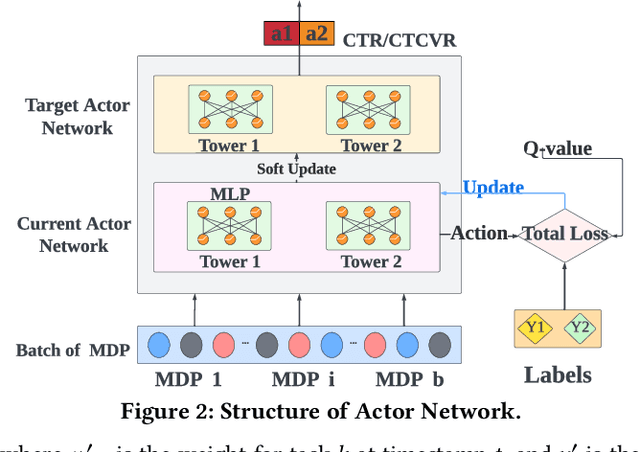
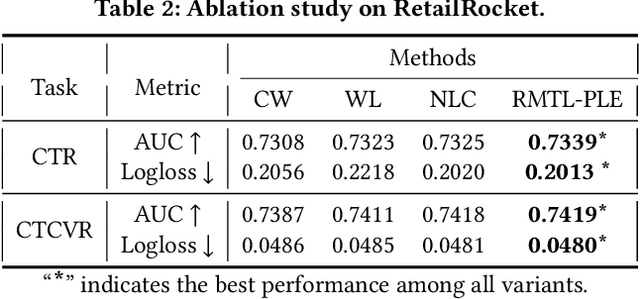
Abstract:In recent years, Multi-task Learning (MTL) has yielded immense success in Recommender System (RS) applications. However, current MTL-based recommendation models tend to disregard the session-wise patterns of user-item interactions because they are predominantly constructed based on item-wise datasets. Moreover, balancing multiple objectives has always been a challenge in this field, which is typically avoided via linear estimations in existing works. To address these issues, in this paper, we propose a Reinforcement Learning (RL) enhanced MTL framework, namely RMTL, to combine the losses of different recommendation tasks using dynamic weights. To be specific, the RMTL structure can address the two aforementioned issues by (i) constructing an MTL environment from session-wise interactions and (ii) training multi-task actor-critic network structure, which is compatible with most existing MTL-based recommendation models, and (iii) optimizing and fine-tuning the MTL loss function using the weights generated by critic networks. Experiments on two real-world public datasets demonstrate the effectiveness of RMTL with a higher AUC against state-of-the-art MTL-based recommendation models. Additionally, we evaluate and validate RMTL's compatibility and transferability across various MTL models.
PtLnc-BXE: Prediction of plant lncRNAs using a Bagging-XGBoost-ensemble method with multiple features
Nov 01, 2019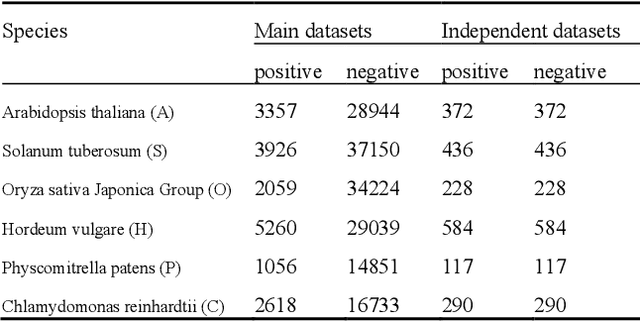
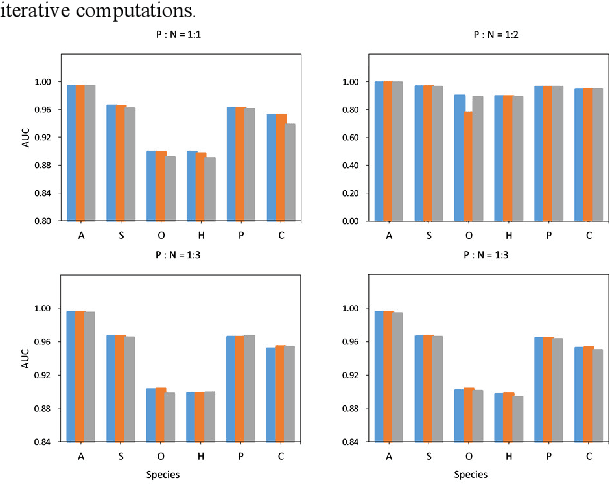
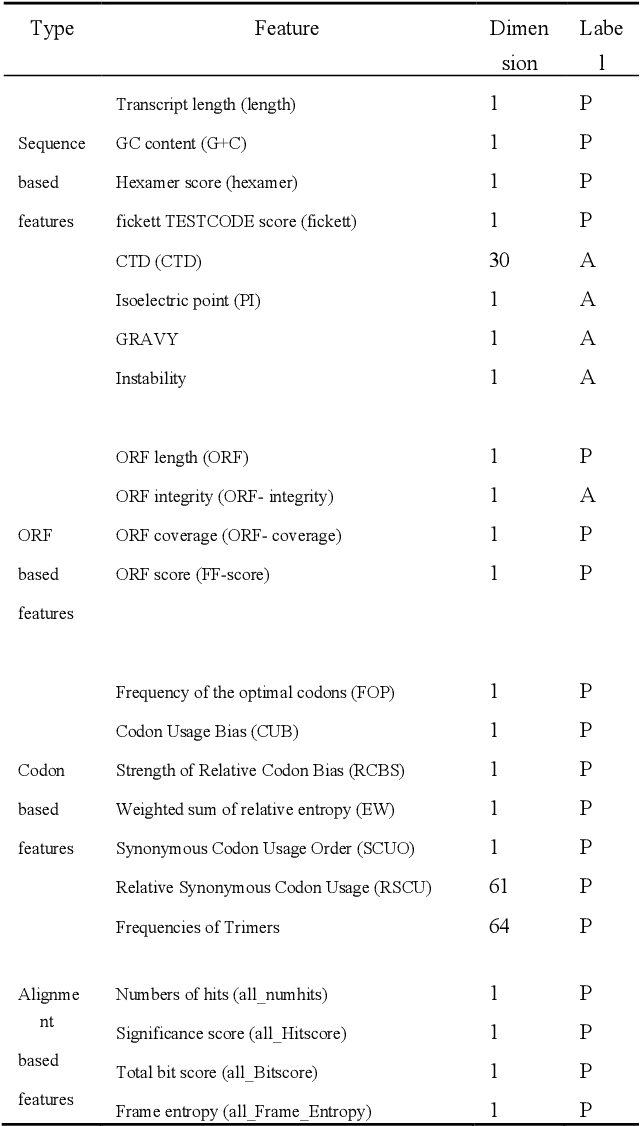
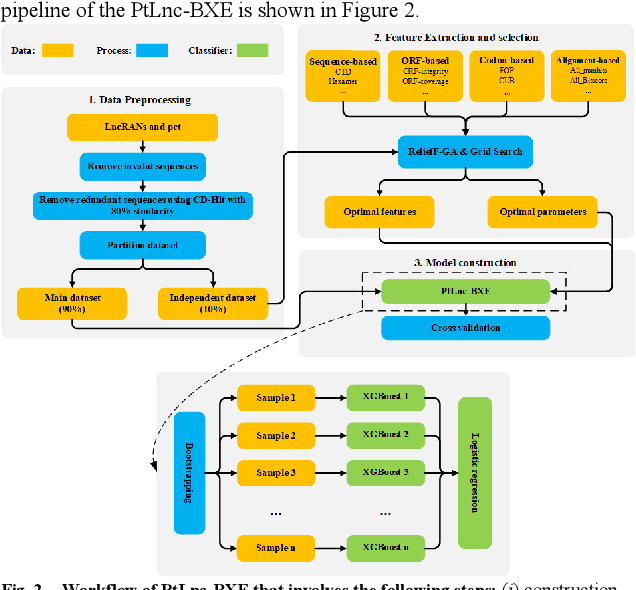
Abstract:Motivation: Long non-coding RNAs (lncRNAs) are a diverse class of RNA molecules with a length above 200 nucleotides that do not encode proteins. Since lncRNAs have involved in a wide range of functions in cellular and developmental processes, an increasing number of methods or tools for distin-guishing lncRNAs from coding RNAs have been proposed. However, most of the existing methods are designed for lncRNAs in animal systems, and only a few methods focus on the plant lncRNA identifica-tion. Different from lncRNAs in animal systems, plant lncRNAs have distinct characteristics. It is desira-ble to develop a computational method for accurate and rapid identification of plant lncRNAs. Results: Herein, we present a plant lncRNA prediction approach PtLnc-BXE, which combines multiple sequence features in two steps to develop an ensemble mode. First, a diverse number of plants lncRNA features are collected and filtered by feature selection and subsequently used to represent RNA se-quences. Then, the training dataset is sampled into several subsets using the bootstrapping technique, and base learners are constructed on data subsets by using XGBoost, and multiple base learners are further combined into a single meta-learner by using logistic regression. PtLnc-BXE outperformed other state-of-the-art plant lncRNA prediction methods, achieving higher AUC (> 95.9%) on the benchmark datasets. The studies across different plant species reveal that the different species have a high overlap between their selected features for modeling. Therefore, it is possible to build the cross-species predic-tion models for plant lncRNAs. Availability: The scripts and data can be downloaded at https://github.com/xxxxx Contact: example@example.org Supplementary information: Supplementary data are available at Bioinformatics online.
 Add to Chrome
Add to Chrome Add to Firefox
Add to Firefox Add to Edge
Add to Edge